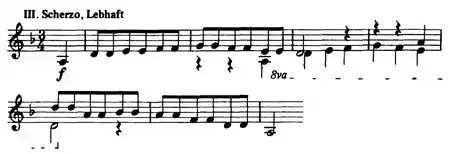Symphony No. 4 (Schumann)
The Symphony No. 4 in D minor, Op. 120, composed by Robert Schumann, was first completed in 1841. Schumann heavily revised the symphony in 1851, and it was this version that reached publication.
Clara Schumann, Robert's widow, later claimed on the first page of the score to the symphony—as published in 1882 as part of her husband's complete works (Robert Schumanns Werke, Herausgegeben von Clara Schumann, published by Breitkopf & Härtel)—that the symphony had merely been sketched in 1841 but was only fully orchestrated ("vollständig instrumentiert") in 1851. However, this was untrue, and Johannes Brahms, who greatly preferred the earlier version of the symphony, published that version in 1891 despite Clara's strenuous objections.
Movements
| External audio | |
|---|---|
| Performed by the Berlin Philharmonic under Herbert von Karajan | |
The work is scored for two flutes, two oboes, two clarinets, two bassoons, four horns, two trumpets, three trombones, timpani and the usual strings.[1]
The 1851 (published) version of the work is in four movements which follow each other without pause:[1]
The 1841 version, however, used Italian rather than German tempo indications, with the four movements as follows:[2]
- Andante con moto — Allegro di molto (D minor–D major)
- Romanza: Andante (A minor–A major)
- Scherzo: Presto (D minor)
- Largo — Finale: Allegro vivace (D major)
Schumann's biographer Peter Ostwald comments that this earlier version is "lighter and more transparent in texture" than the revision, but that Clara "always insisted that the later, heavier, and more stately version [of 1851] was the better one."
The scherzo borrows a theme from Symphony No. 1 in F minor, Op. 7 (1824) by Johann Wenzel Kalliwoda (1801–1866), whom Schumann admired.[3]
Notes
- Steinberg, Michael. "The Symphony: a listeners guide". p. 518-523. Oxford University Press, 1995. ISBN 0-19-512665-3
- Score and parts from IMSLP.
- Fifield, Christopher (2016). The German Symphony between Beethoven and Brahms. Routledge. p. 37. ISBN 978-1409452881. Retrieved 28 December 2018.
References
- John Daverio, "Robert Schumann: Orchestral Works—A Quest for Mastery of the Grand Form," liner notes to Robert Schumann: Complete Symphonies, performed by Orchestre Révolutionnaire et Romantique conducted by John Eliot Gardiner (Archiv Production 289 457 591-2). (Used for publication dates of both versions, other details; also used tempo indications of 1841 version from liner notes.)
- Robert Schumann, Complete Symphonies in Full Score. (NY: Dover Publications, 1980.) ISBN 0-486-24013-4. (Reprint of Clara Schumann's edition of the symphonies; includes her note on p. 310.)
External links
- Symphony No. 4: Scores at the International Music Score Library Project



